Flash revolution
The flash memory revolution ... It has been going on for five years now. And everything is just beginning. Such a radical change in storage technologies that are happening today, has not yet been. Virtually all leading storage vendors in recent years have introduced their own AFA (All-Flash Array) class storage systems built entirely on flash memory. Solid-state drives are widely used in mid-range and high-end servers, significantly improving system performance due to low latency and high-performance SSD (Solid State Drive) solid-state drives in IOPS (I / O operations per second).

The use of SSD significantly reduces the load time of the server operating system, launching applications and virtual machines. SSDs also significantly accelerated latency-sensitive applications, such as transactional databases. In Russia, such systems are being successfully implemented, for example, in insurance companies and banks.
According to the forecast of Transparency Market Research (TMR), the global market for SSD drives of all types until 2022 will grow annually by more than 40% and reach $ 229.4 billion. The segment of corporate-class SSD drives will develop at the highest rates — an average annual growth rate of 76.3%. Among the manufacturers of SSDs of different classes are Lite-on Technology, Kingston Technology, OCZ Storage Solutions, Intel, Western Digital.
')
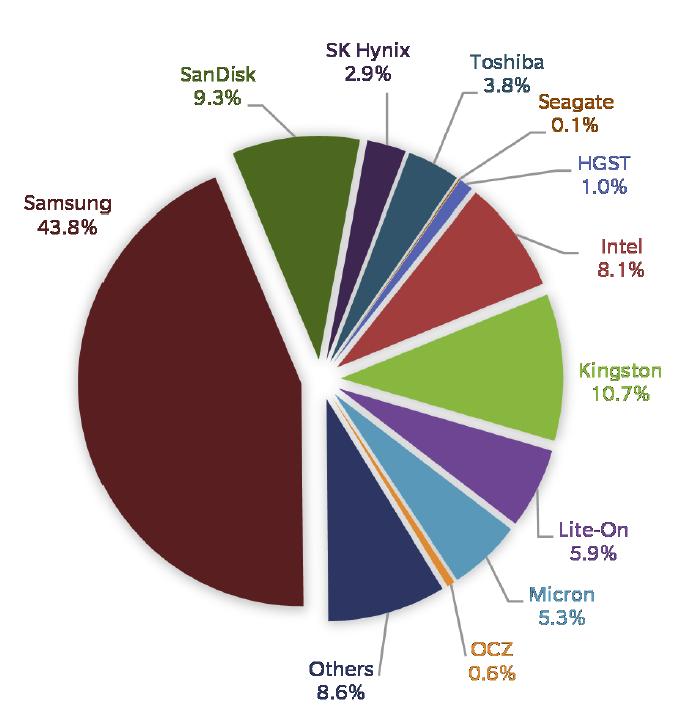
Shares of vendors in the global SSD market in units of products for the second quarter of 2015 ( according to TrendFocus ).

The changing market share of NAND flash memory manufacturers over the past six years.
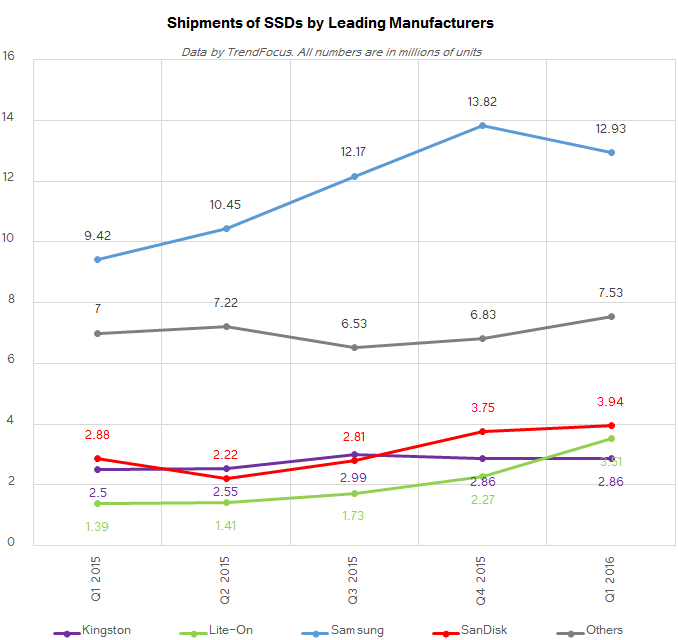
Shipments of SSD drives to the world market by leading vendors in millions of pieces ( TrendFocus data ).
Significant impact on the SSD market has 3D NAND memory, currently used in Samsung 850 and 950 series products. Other vendors are actively working in this direction and next year they will start mass production of 3D flash memory - MLC and TLC. According to SMI, already in 2019, all flash memory will be produced by 3D technology.
In the first quarter of 2016, SSD shipments in the world increased by 32.7% year-on-year (data from TrendFocus). Their total capacity was about 10 exabytes, 77% more than a year ago. And the average capacity of one drive increased by 33%.
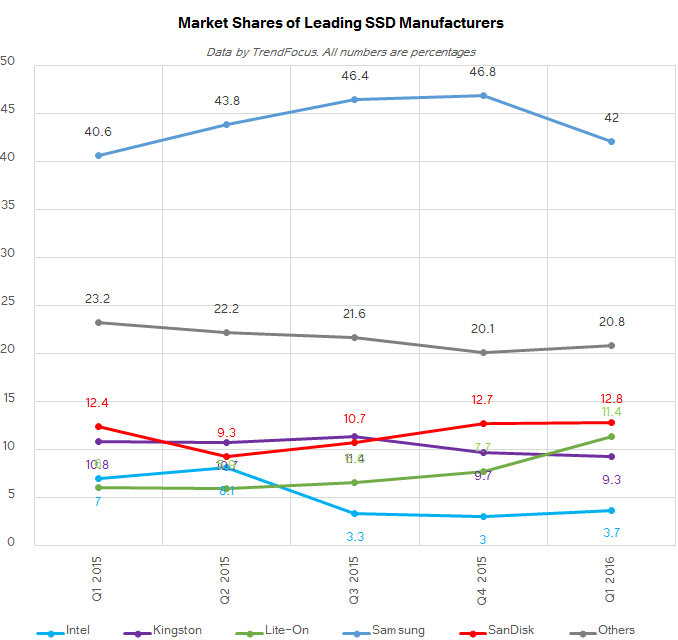
Shares of manufacturers of SSD drives in the world market for the last quarters ( TrendFocus data ).
Devices based on NAND memory actively supplant traditional hard disk drives (HDD). Sales of the latter for the same period fell by 20%. Deliveries of enterprise-class flash drives increased by 69% in the first quarter. In the world about 4 million such devices were sold.
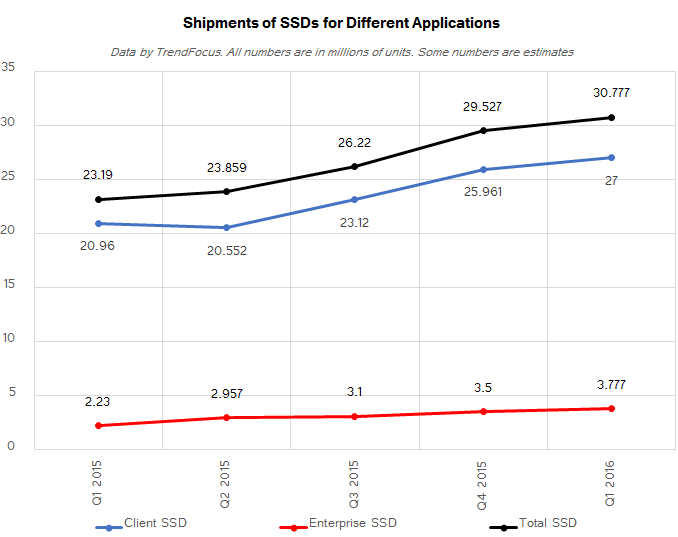
The supply of SSD products to the world market in recent quarters by type of application is customer (blue) and corporate (red) in million pieces ( TrendFocus data ).
Samsung, Intel and HGST are the main suppliers of enterprise-class SSDs. Their total market share is 80%. Samsung also remains the leader in the global SSD market of all types with a share of more than 40%.

Shares of SSD manufacturers in the global market ( data TrendFocus ).
In systems for mission-critical applications, the transition from 10K / 15K HDD disk drives to SSDs continues, but since one enterprise-class SSD drive replaces several HDDs in performance, flash memory with PCIe and SAS interfaces is small. In the first quarter, 164 thousand corporate SSD PCIe and 590 thousand SSD SAS were sold to a measure. Sales of SSD with SATA interface for the same period amounted to 2.95 million devices.
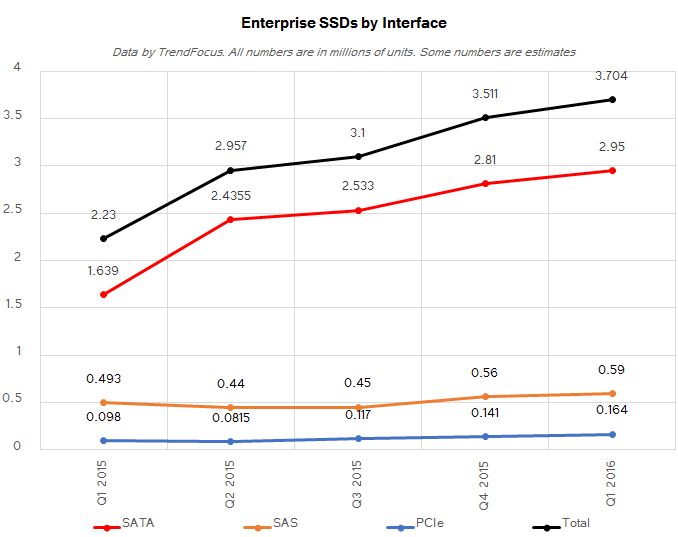
Deliveries of enterprise-class SSD by interface type ( Trendfocus data ). Deliveries of devices with PCIe and SAS interfaces are growing, but at rather slow rates.
Increasing SSD performance by switching to NVMe form factor and new controllers contributed to the introduction of flash memory in high-performance systems, where it continues to crowd out traditional hard disk drives.
Although the prices of solid-state drives are gradually falling, the cost of storing a gigabyte of data on the HDD is still much lower. But with the advent of 3D NAND memory, flash memory prices began to decline rapidly, and it can be expected that the market for corporate HDDs used for storing key operating data will begin to decline.
Compared with hard drives, SSDs have much lower latency, 1000 times better performance in IOPS and three to five times higher throughput. As a result, SSDs get every chance to replace HDD in servers already this year. And in 2017, according to Gartner, sales of SSD drives in the world will exceed sales of HDD in monetary terms.
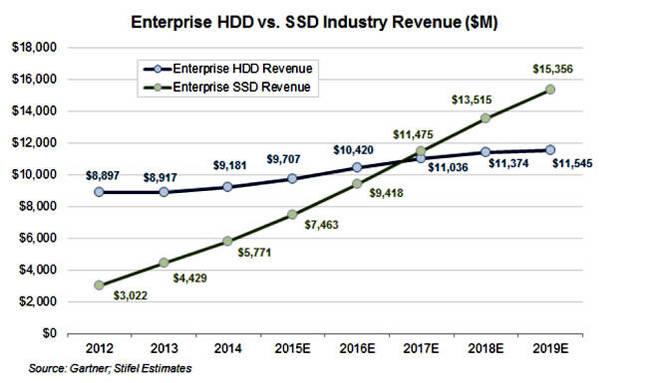
According to Gartner analysts, in 2017, global sales of enterprise-class SSD drives will be ahead of HDD sales. In the next three years, sales of SSD products in the corporate segment (in monetary terms) will grow by an average of 20% per year, while sales of HDDs will increase only by 4%.
Enterprise-class flash memory technologies are developing rapidly, new drive form factors are emerging, and interfaces are being improved. Server SSDs can be divided into two main large segments: NVMe devices with a PCIe interface for the most demanding tasks and SATA drives for other loads.

For example, Dell uses Express Flash NVMe PCIe SSD drives in the newest models of four-socket PowerEdge servers. According to the vendor, they are an order of magnitude better than the traditional I / O SSD in I / O performance.
Server flash drives are available in a variety of form factors:
Solid-State Drive (SSD): similar to traditional HDD. The most common SSDs are 3.5 ", 2.5" and 1.8 ". The thickness of the drives can be different - from the corresponding HDD to 5 mm. They usually have SATA, SAS or NVMe interfaces. So all flash drives are called" SSD "Formally wrong, but for simplicity, we do not follow this rule.
Add-in card (AIC): a typical optional card inserted into a PCIe slot. Such boards can be of different sizes: full or half height and width, full or half length and low profile.
M.2: flash card installed inside the server. It has a width of 22 mm and a length of 30 to 110 mm. It can be installed in special PCIe or SATA slots. Flash memory chips can be located on one side or on both sides of the board. This drive consumes fewer SSD or AIC devices. Initially, the M.2 bus was developed as a faster and more compact replacement for the mSATA.
mSATA: similar to form factor M.2, but designed for portable devices, not for servers.
Disk on Module (DOM): a small module on the motherboard. Usually has a small capacity sufficient to boot the system or for embedded applications.
NVDIMM (non-volatile DIMM): this form factor is designed to install a solid-state drive in a DIMM slot on the memory bus and contains some volatile DRAM memory and non-volatile NVDIMM. Drives of this form factor (Storage Class Memory) run at RAM speed, that is, faster than those installed on the PCIe bus, but require special support at the motherboard and BIOS / UEFI levels in order for the system to recognize different types of memory in the DIMM.
The NVDIMM-N module contains DRAM and NVM, but the system only sees DRAM — standard RDIMM with DRAM-specific capacity and latency. NVM server is not accessed: this memory is used to reserve DRAM and has at least the same capacity as DRAM. Thus, the data stored in the DIMM are protected from power failures: a special capacitor is used for this, the capacity of which is enough to transfer the data to non-volatile memory in the event of a power failure. Otherwise, NVDIMM-N behaves like a normal DRAM module. NVDIMM-N also has another name - NVRAM.
Another type of module, NVDIMM-F, contains only NVM (without DRAM). The NVM drive has typical SSD capacity and supports block access, but it has less latency than other SSDs — usually a few microseconds.
The third type, NVDIMM-P, includes DRAM and NVM, combining the functions NVDIMM-N and NVDIMM-F in one module. One area of flash memory in it is used for block storage, the other - for backup DRAM.
Along with form factors, flash drives are also distinguished by a variety of interfaces.
The following interfaces are used in enterprise-class flash drives:
SATA (Serial ATA): Typically used in low-cost SSD, M.2, DOM and mSATA form factor products. This is a point-to-point interface with speeds up to 6 Gbps.
SAS (Serial Attached SCSI): usually used in enterprise-class SSD and HDD devices. Supports up to 65,535 devices per connection. It has been distributed in enterprise-class arrays, JBOD and servers. Currently, the SAS speed is 12 Gbit / s, in 2018-2019, after the release of PCIe 4.0, its doubling is expected.
U.2 (formerly SFF-8639): Supported in a PCIe / NVMe SSD. U.2 is backward compatible with SAS, which means you can connect NVMe, SAS and SATA devices to it.
PCI Express (PCIe): supports AIC and M.2 form factor devices. AIC has 4 lines, not 16, like PCIe. Accordingly, the speed is 8 Gbit / s. M.2 devices typically use 2 or 4 PCIe lanes. The PCIe 2.0 x2 interface has a theoretical bandwidth of 8 Gb / s (1 Gb / s), with PCIe 2.0 x4 it is 16 Gb / s (2 Gb / s), and with a PCIe 3.0 x4 32 Gb / s (4 Gb / s) However, the actual throughput is approximately 20% lower .
DIMM: now used not only as a memory interface, but also in storage products. DDR4 memory modules support speeds of up to 19.2 GB / s, and the delay is tens of nanoseconds.
Differ flash drives and supported protocols. Protocol - a set of commands for a specific interface. So the SATA interface supports the SATA protocol, SAS - SAS (or SCSI). The relatively new NVMe protocol is designed specifically for non-volatile memory. It requires fewer processor commands to complete an I / O request. NVMe also uses parallelization of operations in multi-core processors. 64K commands per queue and 64K queues are supported, that is, a significant number of pending I / O operations are possible.
One of the goals of NVMe is to significantly reduce latency. Currently NVMe is supported on drives of any form factor with a PCIe interface. However, NVMe devices are quite expensive.
NVMe plans to develop the NVMe over Fabrics protocol, which NVMe will allow to work over long distances using RDMA or Fiber Channel factories.
Today, SSDs are often used in combination with HDDs for caching data when reading or reading / writing. This method works well for improving application performance in the case of external flash arrays, but even better when the flash memory is in the server itself, closer to the processor.
Flash drives are responding to industry trends such as in-memory data arrays, virtualization and cloud services, and new opportunities for optimizing data storage are emerging. And as a result, the data center's economy completely changes.
In some cases, by implementing flash arrays, companies manage to reduce TCO by 33% by a third, multiply the performance of the storage infrastructure, reduce power consumption by half, increase application performance by more than an order of magnitude, and reduce response time by 40% , more than half the cost of supporting storage infrastructure. For commercial data center owners, these technologies allow for entering into SLA agreements for cloud services to guarantee customers a certain speed of access to storage systems (in IOPS).
The Intel Solid-State Data Center for SATA data centers with the Intel S3610 Series expansion drive. Intel DC Series S3710 is a new generation of solid-state drives for data centers optimized for loads with both a large number of write operations and reads.
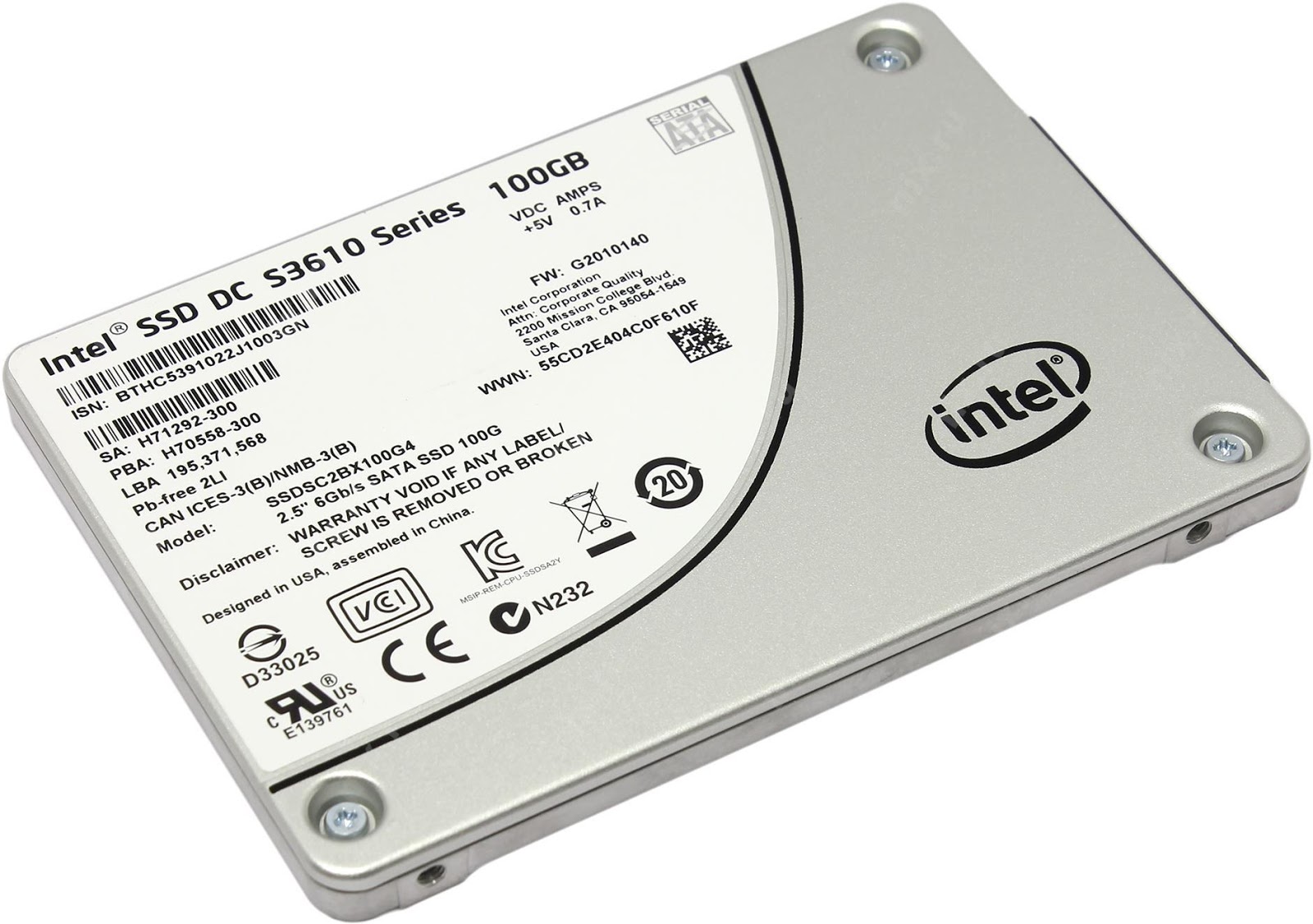
The Intel Solid-State Drive DC S3610 Series provides increased read / write speeds up to 550/5201 MB / s, and read / write speeds in 4 K units up to 84,000/28 0001 IOPS. Typical latency in applications is 55 µs, the maximum latency of read operations is 500 µs over 99.9% of the time. Active power consumption - less than 6.8 watts.
Flash drives have an impact on web hosting, cloud computing. Moreover, when combined into a RAID array, they enable performance in the cloud that cannot be achieved on a home PC. Sometimes customers are given the opportunity to self-assess , which gives the use of enterprise-class SSD for virtual servers.
Leading providers are increasingly using SSD in servers that serve as a platform for virtual client servers (VPS), which usually host websites. Such a hosting option is more expensive, but it is optimal for high-load sites (with a large number of I / O operations), for example, sites with databases, blogs or forums, e-commerce sites, etc. However, it has its own difficulties.
The capacity of solid-state drives for servers is growing rapidly and may soon surpass the capacity of HDD. For example, Samsung has released a SSD in the form factor of 2.5 "with a capacity of 15 TB. With the increase in the density of flash memory NAND drives are becoming more compact. So, the solid-state drive form factor M.2 can be used as a very fast boot media that occupies the server Much less space than 2.5 "HDD.
Meanwhile, server SSD has limitations. And this is not only the sometimes exorbitant price and the cost of storing a gigabyte of data that exceeds the HDD indicators. Such capacity is quite difficult to make publicly accessible, shared between computing nodes of the system, although some operating systems and hypervisors allow you to create such clusters, for example, VMware VSAN 6.2 or Microsoft Server 2016 with support for Storage Spaces Direct. Such software tools allow you to build highly available systems with built-in SATA, SAS or NVMe drives, and they support compression, data deduplication and QoS.
Equipped with SSD servers can effectively solve such tasks as video editing, search in large databases, transaction processing, provide an opportunity to eliminate bottlenecks in virtualization and cloud computing environments.
Modern SSDs are quite durable and can withstand five years of intensive use, that is, they fit into the life cycle of the server.
Compared with hard drives, SSDs have much lower latency, 1000 times better performance in IOPS and three to five times higher throughput. As a result, SSDs get every chance to replace HDD in servers already this year. And in 2017, according to Gartner, sales of SSD in the world will exceed sales of HDD in monetary terms.
Meanwhile, when using SSDs, most RAID controllers in RAID 5 mode become a bottleneck in the system, therefore, it is recommended to use RAID 1 or 10 in a software implementation to protect data. And for tasks with intensive recording (data collection from sensors, video recording, etc.), SSDs with extended service life may be required - they are produced by several vendors.
Examples are also indicative of the use of new generation flash memory by leading vendors in their flagship storage systems.

HPE continues to work on optimizing its 3PAR flash system. For these purposes, the latest generation of 3D NAND flash memory is used in drives with a capacity of 7.68 and 15.36 TB. The latter is more than 15 times greater than HDD 1.8 "10K with 10 times less delay. The advanced HPE Adaptive Sparing technology dynamically assigns not only spare, but also unused capacity, which helps the drive's internal" garbage collection "with large containers. with the increase in the total capacity of the system, the data access interface did not become a bottleneck; Express Layout technology is used, which allows both controllers in a pair of nodes to work in parallel with SSD via the SAS 12 Gb / s interface.
Flash memory is becoming a mass product, “diskless” data center entirely built on flash drives is already a reality, new SSD drives and interfaces are on the way, and Storage Class Memory and NVMe are actively developing.
There are also a number of applications that do not need high IOPS, but require a very small and predictable delay. The new generation of drives is the best suited for such tasks.
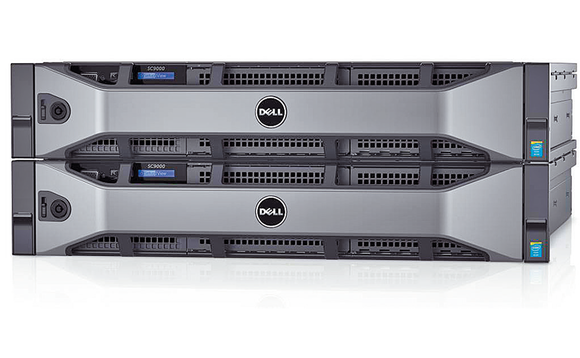
The Dell SC9000 storage system uses the new Dell PowerEdge server platform with four 8-core 3.2 GHz processors and RAM up to 512 GB. The capacity of the flash array is up to 46 TB per 1U (without data compression). This density was achieved thanks to the use of three-level flash memory Samsung TLC 3D NAND in the storage system. To increase 3D NAND's lifespan, Dell engineers used a tiring mechanism — moving data between storage levels. The first level is represented by SLC or eMLC flash memory, which can withstand a large number of rewriting cycles, the second - by 3D NAND memory, in which relatively rarely used data is written, and in compressed form. Some models have a third level - HDD. For even more economical use of storage capacity, you can use deduplication mechanisms. The system configuration (the ratio of the capacity of different types of flash memory and hard drives) can be selected based on the nature of the load.
With the introduction of 3D technology, NAND has significantly increased the density of flash memory. The near future (2017) - the emergence of QLC flash memory on the market with four bits per cell costing $ 30 per terabyte of capacity. SSD capacity will exceed the capacity of disk drives, which is approaching the physical limit. Already announced SSD capacity of 16 TB, and by 2020 there will be flash memory with a capacity of 40 TB per device.
Among the new developments is X-Point memory from Intel / Micron, which will compete in speed with NVMe drives, but will require changes in the system software. Its mass introduction may begin in 2017.

Samsung announced the fourth generation of 3D NAND - with 64 layers instead of 48 and increased interface speed to 800 Mbps. The storage capacity of 11.5x13 mm on TLC memory is 1 TB. The former 16TB PM1633a SAS SSD product is replaced by a new 32TB PM1643 drive, and the PM1725 PCIe card is supplemented with a PM1735 model with 4x8 PCIe interface.
Lenovo, along with partners such as Seagate, NxGn Data and Amphenol, is developing a solid-state drive for servers and storage systems (Project Spark). The Lenovo drive is small and is designed for installation in 1U rack servers, supports hot swapping. One of the versions of this drive has a capacity of 48 TB and takes the place of two 2.5-inch drives.
Even today, SSDs for data centers improve data processing efficiency, offer premium quality and reduce energy costs. New developments open up prospects that are now even difficult to imagine, and can lead to radical changes in the architecture of computing systems and data centers.

The use of SSD significantly reduces the load time of the server operating system, launching applications and virtual machines. SSDs also significantly accelerated latency-sensitive applications, such as transactional databases. In Russia, such systems are being successfully implemented, for example, in insurance companies and banks.
World market of SSD drives
According to the forecast of Transparency Market Research (TMR), the global market for SSD drives of all types until 2022 will grow annually by more than 40% and reach $ 229.4 billion. The segment of corporate-class SSD drives will develop at the highest rates — an average annual growth rate of 76.3%. Among the manufacturers of SSDs of different classes are Lite-on Technology, Kingston Technology, OCZ Storage Solutions, Intel, Western Digital.
')

Shares of vendors in the global SSD market in units of products for the second quarter of 2015 ( according to TrendFocus ).

The changing market share of NAND flash memory manufacturers over the past six years.

Shipments of SSD drives to the world market by leading vendors in millions of pieces ( TrendFocus data ).
Significant impact on the SSD market has 3D NAND memory, currently used in Samsung 850 and 950 series products. Other vendors are actively working in this direction and next year they will start mass production of 3D flash memory - MLC and TLC. According to SMI, already in 2019, all flash memory will be produced by 3D technology.
In the first quarter of 2016, SSD shipments in the world increased by 32.7% year-on-year (data from TrendFocus). Their total capacity was about 10 exabytes, 77% more than a year ago. And the average capacity of one drive increased by 33%.

Shares of manufacturers of SSD drives in the world market for the last quarters ( TrendFocus data ).
Devices based on NAND memory actively supplant traditional hard disk drives (HDD). Sales of the latter for the same period fell by 20%. Deliveries of enterprise-class flash drives increased by 69% in the first quarter. In the world about 4 million such devices were sold.

The supply of SSD products to the world market in recent quarters by type of application is customer (blue) and corporate (red) in million pieces ( TrendFocus data ).
Samsung, Intel and HGST are the main suppliers of enterprise-class SSDs. Their total market share is 80%. Samsung also remains the leader in the global SSD market of all types with a share of more than 40%.

Shares of SSD manufacturers in the global market ( data TrendFocus ).
In systems for mission-critical applications, the transition from 10K / 15K HDD disk drives to SSDs continues, but since one enterprise-class SSD drive replaces several HDDs in performance, flash memory with PCIe and SAS interfaces is small. In the first quarter, 164 thousand corporate SSD PCIe and 590 thousand SSD SAS were sold to a measure. Sales of SSD with SATA interface for the same period amounted to 2.95 million devices.

Deliveries of enterprise-class SSD by interface type ( Trendfocus data ). Deliveries of devices with PCIe and SAS interfaces are growing, but at rather slow rates.
Increasing SSD performance by switching to NVMe form factor and new controllers contributed to the introduction of flash memory in high-performance systems, where it continues to crowd out traditional hard disk drives.
Although the prices of solid-state drives are gradually falling, the cost of storing a gigabyte of data on the HDD is still much lower. But with the advent of 3D NAND memory, flash memory prices began to decline rapidly, and it can be expected that the market for corporate HDDs used for storing key operating data will begin to decline.
Compared with hard drives, SSDs have much lower latency, 1000 times better performance in IOPS and three to five times higher throughput. As a result, SSDs get every chance to replace HDD in servers already this year. And in 2017, according to Gartner, sales of SSD drives in the world will exceed sales of HDD in monetary terms.

According to Gartner analysts, in 2017, global sales of enterprise-class SSD drives will be ahead of HDD sales. In the next three years, sales of SSD products in the corporate segment (in monetary terms) will grow by an average of 20% per year, while sales of HDDs will increase only by 4%.
Enterprise-class flash memory technologies are developing rapidly, new drive form factors are emerging, and interfaces are being improved. Server SSDs can be divided into two main large segments: NVMe devices with a PCIe interface for the most demanding tasks and SATA drives for other loads.

For example, Dell uses Express Flash NVMe PCIe SSD drives in the newest models of four-socket PowerEdge servers. According to the vendor, they are an order of magnitude better than the traditional I / O SSD in I / O performance.
Form factors of corporate SSD drives
Server flash drives are available in a variety of form factors:
Solid-State Drive (SSD): similar to traditional HDD. The most common SSDs are 3.5 ", 2.5" and 1.8 ". The thickness of the drives can be different - from the corresponding HDD to 5 mm. They usually have SATA, SAS or NVMe interfaces. So all flash drives are called" SSD "Formally wrong, but for simplicity, we do not follow this rule.
Add-in card (AIC): a typical optional card inserted into a PCIe slot. Such boards can be of different sizes: full or half height and width, full or half length and low profile.
M.2: flash card installed inside the server. It has a width of 22 mm and a length of 30 to 110 mm. It can be installed in special PCIe or SATA slots. Flash memory chips can be located on one side or on both sides of the board. This drive consumes fewer SSD or AIC devices. Initially, the M.2 bus was developed as a faster and more compact replacement for the mSATA.
mSATA: similar to form factor M.2, but designed for portable devices, not for servers.
Disk on Module (DOM): a small module on the motherboard. Usually has a small capacity sufficient to boot the system or for embedded applications.
NVDIMM (non-volatile DIMM): this form factor is designed to install a solid-state drive in a DIMM slot on the memory bus and contains some volatile DRAM memory and non-volatile NVDIMM. Drives of this form factor (Storage Class Memory) run at RAM speed, that is, faster than those installed on the PCIe bus, but require special support at the motherboard and BIOS / UEFI levels in order for the system to recognize different types of memory in the DIMM.
The NVDIMM-N module contains DRAM and NVM, but the system only sees DRAM — standard RDIMM with DRAM-specific capacity and latency. NVM server is not accessed: this memory is used to reserve DRAM and has at least the same capacity as DRAM. Thus, the data stored in the DIMM are protected from power failures: a special capacitor is used for this, the capacity of which is enough to transfer the data to non-volatile memory in the event of a power failure. Otherwise, NVDIMM-N behaves like a normal DRAM module. NVDIMM-N also has another name - NVRAM.
Another type of module, NVDIMM-F, contains only NVM (without DRAM). The NVM drive has typical SSD capacity and supports block access, but it has less latency than other SSDs — usually a few microseconds.
The third type, NVDIMM-P, includes DRAM and NVM, combining the functions NVDIMM-N and NVDIMM-F in one module. One area of flash memory in it is used for block storage, the other - for backup DRAM.
Along with form factors, flash drives are also distinguished by a variety of interfaces.
Interfaces and protocols of flash drives
The following interfaces are used in enterprise-class flash drives:
SATA (Serial ATA): Typically used in low-cost SSD, M.2, DOM and mSATA form factor products. This is a point-to-point interface with speeds up to 6 Gbps.
SAS (Serial Attached SCSI): usually used in enterprise-class SSD and HDD devices. Supports up to 65,535 devices per connection. It has been distributed in enterprise-class arrays, JBOD and servers. Currently, the SAS speed is 12 Gbit / s, in 2018-2019, after the release of PCIe 4.0, its doubling is expected.
U.2 (formerly SFF-8639): Supported in a PCIe / NVMe SSD. U.2 is backward compatible with SAS, which means you can connect NVMe, SAS and SATA devices to it.
PCI Express (PCIe): supports AIC and M.2 form factor devices. AIC has 4 lines, not 16, like PCIe. Accordingly, the speed is 8 Gbit / s. M.2 devices typically use 2 or 4 PCIe lanes. The PCIe 2.0 x2 interface has a theoretical bandwidth of 8 Gb / s (1 Gb / s), with PCIe 2.0 x4 it is 16 Gb / s (2 Gb / s), and with a PCIe 3.0 x4 32 Gb / s (4 Gb / s) However, the actual throughput is approximately 20% lower .
DIMM: now used not only as a memory interface, but also in storage products. DDR4 memory modules support speeds of up to 19.2 GB / s, and the delay is tens of nanoseconds.
Differ flash drives and supported protocols. Protocol - a set of commands for a specific interface. So the SATA interface supports the SATA protocol, SAS - SAS (or SCSI). The relatively new NVMe protocol is designed specifically for non-volatile memory. It requires fewer processor commands to complete an I / O request. NVMe also uses parallelization of operations in multi-core processors. 64K commands per queue and 64K queues are supported, that is, a significant number of pending I / O operations are possible.
One of the goals of NVMe is to significantly reduce latency. Currently NVMe is supported on drives of any form factor with a PCIe interface. However, NVMe devices are quite expensive.
NVMe plans to develop the NVMe over Fabrics protocol, which NVMe will allow to work over long distances using RDMA or Fiber Channel factories.
SSD in data centers: diskless data center
Today, SSDs are often used in combination with HDDs for caching data when reading or reading / writing. This method works well for improving application performance in the case of external flash arrays, but even better when the flash memory is in the server itself, closer to the processor.
Flash drives are responding to industry trends such as in-memory data arrays, virtualization and cloud services, and new opportunities for optimizing data storage are emerging. And as a result, the data center's economy completely changes.
In some cases, by implementing flash arrays, companies manage to reduce TCO by 33% by a third, multiply the performance of the storage infrastructure, reduce power consumption by half, increase application performance by more than an order of magnitude, and reduce response time by 40% , more than half the cost of supporting storage infrastructure. For commercial data center owners, these technologies allow for entering into SLA agreements for cloud services to guarantee customers a certain speed of access to storage systems (in IOPS).
The Intel Solid-State Data Center for SATA data centers with the Intel S3610 Series expansion drive. Intel DC Series S3710 is a new generation of solid-state drives for data centers optimized for loads with both a large number of write operations and reads.

The Intel Solid-State Drive DC S3610 Series provides increased read / write speeds up to 550/5201 MB / s, and read / write speeds in 4 K units up to 84,000/28 0001 IOPS. Typical latency in applications is 55 µs, the maximum latency of read operations is 500 µs over 99.9% of the time. Active power consumption - less than 6.8 watts.
Flash drives have an impact on web hosting, cloud computing. Moreover, when combined into a RAID array, they enable performance in the cloud that cannot be achieved on a home PC. Sometimes customers are given the opportunity to self-assess , which gives the use of enterprise-class SSD for virtual servers.
Leading providers are increasingly using SSD in servers that serve as a platform for virtual client servers (VPS), which usually host websites. Such a hosting option is more expensive, but it is optimal for high-load sites (with a large number of I / O operations), for example, sites with databases, blogs or forums, e-commerce sites, etc. However, it has its own difficulties.
Flash memory in servers: capacity and limitations
The capacity of solid-state drives for servers is growing rapidly and may soon surpass the capacity of HDD. For example, Samsung has released a SSD in the form factor of 2.5 "with a capacity of 15 TB. With the increase in the density of flash memory NAND drives are becoming more compact. So, the solid-state drive form factor M.2 can be used as a very fast boot media that occupies the server Much less space than 2.5 "HDD.
Meanwhile, server SSD has limitations. And this is not only the sometimes exorbitant price and the cost of storing a gigabyte of data that exceeds the HDD indicators. Such capacity is quite difficult to make publicly accessible, shared between computing nodes of the system, although some operating systems and hypervisors allow you to create such clusters, for example, VMware VSAN 6.2 or Microsoft Server 2016 with support for Storage Spaces Direct. Such software tools allow you to build highly available systems with built-in SATA, SAS or NVMe drives, and they support compression, data deduplication and QoS.
Equipped with SSD servers can effectively solve such tasks as video editing, search in large databases, transaction processing, provide an opportunity to eliminate bottlenecks in virtualization and cloud computing environments.
Modern SSDs are quite durable and can withstand five years of intensive use, that is, they fit into the life cycle of the server.
Compared with hard drives, SSDs have much lower latency, 1000 times better performance in IOPS and three to five times higher throughput. As a result, SSDs get every chance to replace HDD in servers already this year. And in 2017, according to Gartner, sales of SSD in the world will exceed sales of HDD in monetary terms.
Meanwhile, when using SSDs, most RAID controllers in RAID 5 mode become a bottleneck in the system, therefore, it is recommended to use RAID 1 or 10 in a software implementation to protect data. And for tasks with intensive recording (data collection from sensors, video recording, etc.), SSDs with extended service life may be required - they are produced by several vendors.
Flash memory in storage: what it gives
Examples are also indicative of the use of new generation flash memory by leading vendors in their flagship storage systems.

HPE continues to work on optimizing its 3PAR flash system. For these purposes, the latest generation of 3D NAND flash memory is used in drives with a capacity of 7.68 and 15.36 TB. The latter is more than 15 times greater than HDD 1.8 "10K with 10 times less delay. The advanced HPE Adaptive Sparing technology dynamically assigns not only spare, but also unused capacity, which helps the drive's internal" garbage collection "with large containers. with the increase in the total capacity of the system, the data access interface did not become a bottleneck; Express Layout technology is used, which allows both controllers in a pair of nodes to work in parallel with SSD via the SAS 12 Gb / s interface.
Flash memory is becoming a mass product, “diskless” data center entirely built on flash drives is already a reality, new SSD drives and interfaces are on the way, and Storage Class Memory and NVMe are actively developing.
There are also a number of applications that do not need high IOPS, but require a very small and predictable delay. The new generation of drives is the best suited for such tasks.

The Dell SC9000 storage system uses the new Dell PowerEdge server platform with four 8-core 3.2 GHz processors and RAM up to 512 GB. The capacity of the flash array is up to 46 TB per 1U (without data compression). This density was achieved thanks to the use of three-level flash memory Samsung TLC 3D NAND in the storage system. To increase 3D NAND's lifespan, Dell engineers used a tiring mechanism — moving data between storage levels. The first level is represented by SLC or eMLC flash memory, which can withstand a large number of rewriting cycles, the second - by 3D NAND memory, in which relatively rarely used data is written, and in compressed form. Some models have a third level - HDD. For even more economical use of storage capacity, you can use deduplication mechanisms. The system configuration (the ratio of the capacity of different types of flash memory and hard drives) can be selected based on the nature of the load.
Flash Perspectives
With the introduction of 3D technology, NAND has significantly increased the density of flash memory. The near future (2017) - the emergence of QLC flash memory on the market with four bits per cell costing $ 30 per terabyte of capacity. SSD capacity will exceed the capacity of disk drives, which is approaching the physical limit. Already announced SSD capacity of 16 TB, and by 2020 there will be flash memory with a capacity of 40 TB per device.
Among the new developments is X-Point memory from Intel / Micron, which will compete in speed with NVMe drives, but will require changes in the system software. Its mass introduction may begin in 2017.

Samsung announced the fourth generation of 3D NAND - with 64 layers instead of 48 and increased interface speed to 800 Mbps. The storage capacity of 11.5x13 mm on TLC memory is 1 TB. The former 16TB PM1633a SAS SSD product is replaced by a new 32TB PM1643 drive, and the PM1725 PCIe card is supplemented with a PM1735 model with 4x8 PCIe interface.
Lenovo, along with partners such as Seagate, NxGn Data and Amphenol, is developing a solid-state drive for servers and storage systems (Project Spark). The Lenovo drive is small and is designed for installation in 1U rack servers, supports hot swapping. One of the versions of this drive has a capacity of 48 TB and takes the place of two 2.5-inch drives.
Even today, SSDs for data centers improve data processing efficiency, offer premium quality and reduce energy costs. New developments open up prospects that are now even difficult to imagine, and can lead to radical changes in the architecture of computing systems and data centers.
Source: https://habr.com/ru/post/308038/
All Articles